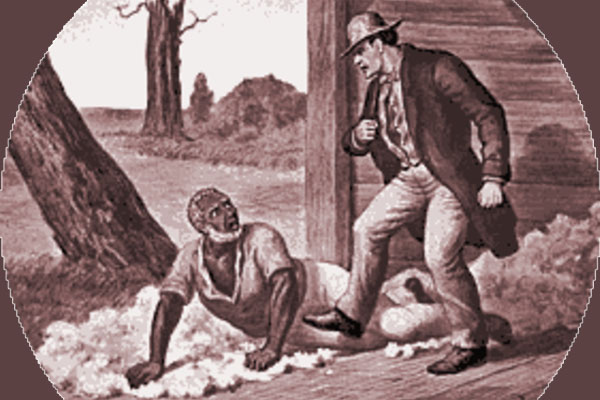 |
| Simon Legree assaults Uncle Tom (Wikipedia) |
Note: Harriet Beecher Stowe's masterpiece had an impact--positive and negative--on American race relations that has lasted to this day. Learn the story in this lesson.
Get Ready: What do you know of the history of slavery in America?
Few novels have had an impact on their cultures as great as that of Uncle Tom's Cabin, an 1852 anti-slavery novel by the school teacher and abolitionist Harriet Beecher Stowe. Subtitled "Life Among the Lowly," it is said to have "helped lay the groundwork for the [American] Civil War."
After the Bible, it was the best-selling American book of the 19th century. So great was its impact that president Abraham Lincoln, upon meeting the author at the start of the Civil War (when Stowe was around 50) is said to have declared, "So this is the little lady who started this great war" (though some doubt the anecdote).
Stowe's sentimental book was not only read by many, but it lent itself to dramatization, so that many more were exposed to its story on the stage. Even today, the black stereotypes it promoted hold an important place in popular culture--sometimes in negative ways.
The story tells of Uncle Tom, an enslaved older black man and his friends and family on the plantation of a Kentucky farmer named Arthur Shelby. The farmer may lose his farm due to debts, and decides to sell two of his slaves, including Tom, who has been something of a mentor to Arthur's son George.
The buyer, a Mr. Haley, is a slave trader of evil repute. The sale will separate Tom and the other slave, a boy named Harry, from their families. Harry's mother, Eliza, learns of the impending sale, and runs away with her son.
Tom, meanwhile, is taken down the Mississippi River to be sold at a slave market. On the way he befriends a little white girl named Eva. When she falls into the river, Tom dives in and saves her life; for this, Eva's grateful father buys Tom and takes him to their home in New Orleans.
Meanwhile, Eva and Harry meet up with Eva's husband George, and they head for Canada (which did not allow slavery). But along the way, George shoots a slave hunter named Loker, and, worried that he may die, they take him to a group of Quakers for treatment.
In New Orleans, little Eva falls ill and dies. Her father, wishing to become a better man, pledges to free Tom, but is killed before he has the chance. His widow sells Tom to Simon Legree, a vicious plantation owner who abuses Tom, trying to break his spirit.
Loker, the slave hunter, re-enters the story. He is a changed man after he recovers from his shooting, and has helped Eliza and her family cross safely into Canada. Uncle Tom, meanwhile, has encouraged two of the abused female slaves to escape. When he refuses to tell Legree where they have gone, Legree has him beaten to death by his overseers, Quimbo and Sambo--whom Tom forgives as he lies dying.
George Shelby, son of Tom's original owner, arrives to buy Tom's freedom and save his life, but he is too late. Shelby returns to Kentucky and, after his father's death, frees his slaves, reminding them that every time they see Uncle Tom's old cabin, they should remember the sacrifices he made for others.
--------Read more: https://en.wikipedia.org/wiki/Uncle_Tom's_Cabin
Practice: Match the term to its definition below:
- abolitionist
- anecdote
- befriends
- cabin
- groundwork
- impending
- overseers
- pledges
- Quakers
- vicious
- the foundation; the basis
- a small, simple house
- becomes friends with
- promises
- members of a religious group known for its good works
- savage; evil
- about to happen
- one who wishes to see the end of slavery
- managers; bosses
- a short, often amusing, story
Answers are in the first comment below.
Submitted to the Shenzhen Daily for April 12, 2021


Answers to the Practice: 1. h; 2. j; 3. c; 4. b; 5. a; 6. g; 7. i; 8. d; 9. e; 10. f
ReplyDelete